Hunter Rebecca Francis Has a Thing or Two to Teach Us About the Wild
In an age of social-media shaming, a single tweet can launch a crusade. But maybe Ricky Gervais should have picked another woman to mess with.
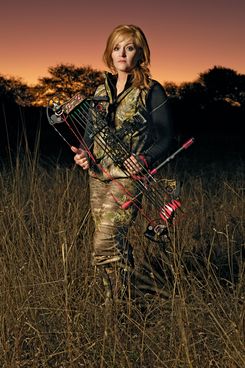
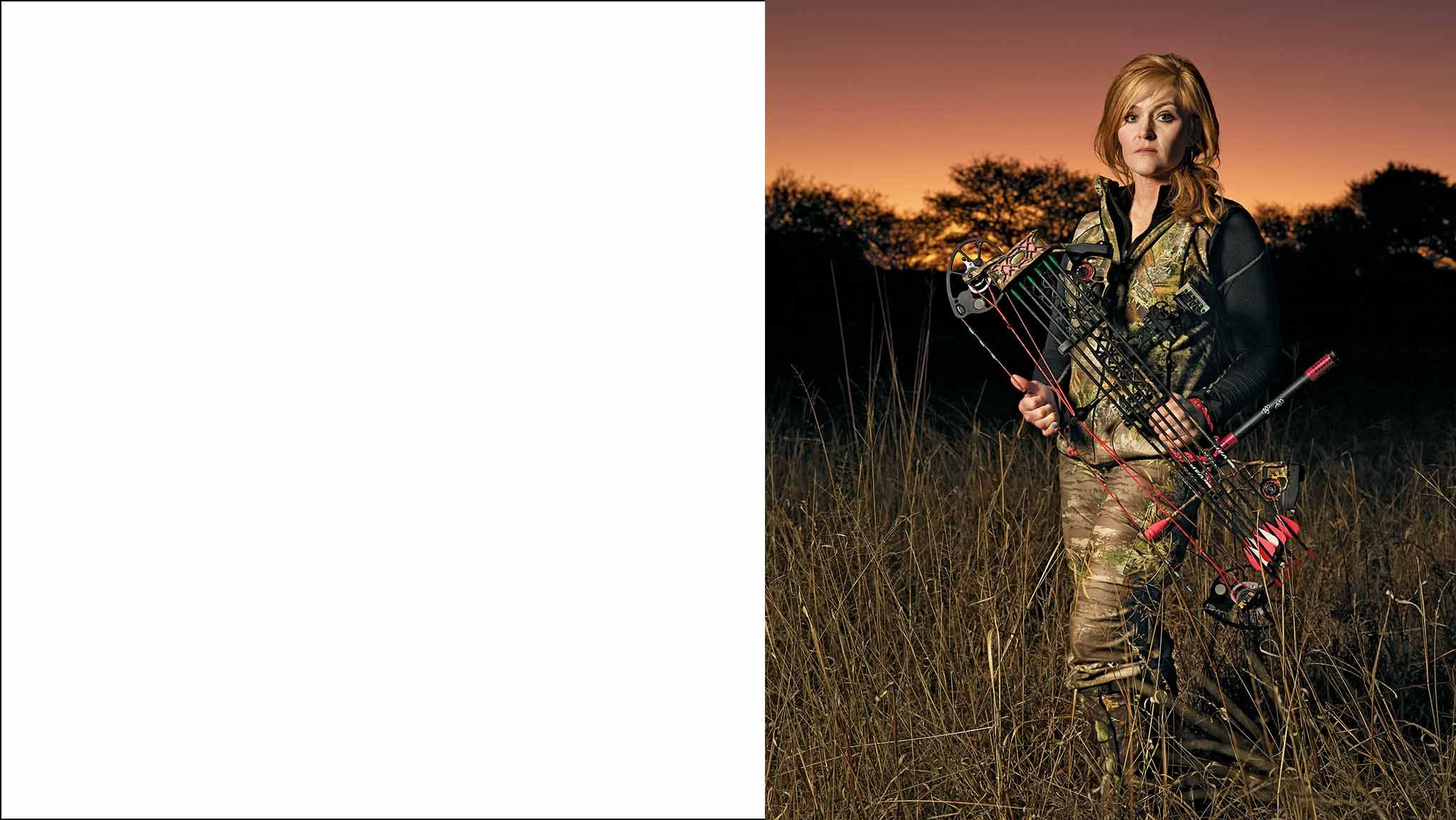
There is no way around this: At 4:30 a.m., as we embark on the two-hour journey that will take us to some hunting grounds in northwest South Africa, a.k.a. “the Bush,” Rebecca Francis is wearing a full-on smoky eye. Her lids are lined and her lashes plumped, her lips shimmer a glossy pink. She is carrying her weapon, a Mathews Chill SDX dual-cam bow with hot-pink detailing, marketed to women “who may be small in stature, but demand big performance,” and from which she has every intention of plunging an arrow into the chest of a 500-pound sable antelope, where it will, if all goes as planned, pierce the animal’s lungs. Am I underdone? I wonder, a thought I immediately recognize as insane.
Francis is a peppy, ever-smiling 41-year-old mother of three, stepmother of five, and grandmother of nine who looks 31 and speaks with the elongated vowels of a northern Midwesterner, though she hails from Utah and lives ten miles from anything on 11 acres in Wyoming, where she keeps two dogs, three cats and seven kittens, seven horses, and chickens she calls “so stinkin’ cute I cannot stand it.” She’s an occasional dental hygienist and not-quite-practicing Mormon. (“I have questions,” she will tell me later, those questions involving a gay son of whom she is deeply protective and a theology that frames his orientation as a choice. Then she will take a long sip of red wine.) She is a mix of impulsive life decisions — having a son outside marriage right out of high school and marrying, at 22, a dentist with custody of his five children (“I don’t know what I was thinking,” Francis says now) — and immense patience, capable of the kind of determined composure it takes to remain perfectly still for four hours so a herd of elk do not notice you even as flies creep into your mask and fly legs tickle your cheeks. “Patient” is, in fact, how our massive, square-chested, rugby-playing Afrikaner guide, John Faul, describes Francis, by which he means that whereas his average client, a rifle-toting male CEO, will fire even when he shouldn’t, wounding an animal Faul will then have to kill, Francis waits for a clear shot, and if the opportunity doesn’t present itself, she puts down the pink bow.
In April, the British comedian Ricky Gervais found a photo of Francis beaming beside a limp giraffe, which he promptly tweeted to his nearly 8 million followers, asking: “What must’ve happened to you in your life to make you want to kill a beautiful animal & then lie next to it smiling?” Owing to the rather spirited nature of the response, Francis now considers herself “the most hated woman in the world.” Her public Facebook page is deactivated, her website is down, and she is ignoring media requests, of which there have been many. She responded to my email only accidentally, then apologized; she shouldn’t be talking to anyone, she said, “due to the endless death threats.”
I persuaded her to make an exception, and so we are on our way to GeoDot Wildsplaas, one of at least 9,000 wildlife ranches in South Africa. We are two of the 7,000-plus rifle-and/or-bow-toting tourist-hunters, most of whom are Americans of considerable means, who come to this country every year to hunt animals unhuntable elsewhere.
Back in the U.S., Francis bush-planes into open public land, often amid the alders of darkest Alaska, where she hunts and guides other women for three months a year. Out there, she shoots what she is fortunate enough to find. Here in Limpopo, you pay by the kill, which you select from a price list: warthog, $350; hippo, $9,400; elephant, $42,000. The industry supports professional hunters, field dressers, farmers, and at least one magazine, called Wildlife Ranching, a recent issue of which invites you to start your very own line of Cape buffalo with an advertisement for a pregnant, $200,000 cow named Delila under the headline “Her beauty will haunt you.”
Today, Francis is after a $6,000 sable antelope. It is winter in Limpopo, the country’s poorest and northernmost province, and the land inside these 6,000 fenced acres is all tall dry grass, brown denuded trees, and thirsty red clay. Emu run past us, and in the distance a couple of zebras watch. “Look!” says Francis, leaning out of the jeep into the wind, and within a thicket of yellow trees two shapes resolve into giraffes.
I imagine we’ll traipse into some far-off thicket of trees and spend the day immersed in the kind of poetic sensory awareness befitting a 19th-century safari, peering through tall grass, awake to each branch-crack and sprig-rustle. I imagine that this will be taxing both emotionally and physically. Instead, we arrive at a tiny, dark, stale-smelling hut with a dirt floor on which are parked three white plastic chairs. In the wall of the hut there is a hole through which may pass a bullet or an arrow aimed at a small pond a few yards away. Francis and Faul tiptoe into the room and lower themselves into chairs, taking care that their clothes don’t brush loudly against the plastic. Slowly — very slowly — it dawns on me that this experience will require an entirely different kind of endurance.
Three hours in, Francis sticks her hand out the hole and throws some powder into the air, where it whorls like snow. It’s best to stay downwind of an animal you’re after, but the breeze comes from all directions, throwing our scent into the field. I am growing sick with hunger. John has a cooler full of food. He hands me a carrot. I bite the carrot. John and Rebecca look at me. I take the carrot out of my mouth and put it in my pocket.
There are many ways that this exercise might be made easier and, in fact, is made easier for hunters without Francis’s sense of sportingness. We might, for instance, hunt in a more circumscribed area, or one with a single watering hole instead of five. We might drug the animal into a sluggish stupor, which is a common accusation made against lion hunters. We might hunt with a rifle instead of a bow. But we do none of these things. Instead, we wait for the sable to make a mistake.
I am a person who finds the sedentary, three-minute Shavasana post-yoga coda almost too much stillness to endure. Five hours in, we’ve been visited by many warthogs (“So cute!” she says), nyala antelope (“Oh, heavens!”), and a tsessebe (“Oh my gosh!”), but not the particular sable Francis has permission to “take,” and so the bow remains tilted against the blind.
There’s a dot on Francis’s hand. “That’s a pepper tick,” she says pleasantly and flicks it off.
The sun fades to dusk, John urinates in a bottle while Francis and I contemplate male privilege, and as we close in on 11 hours, we hear the rumble of the jeep that’s come to pick us up. We climb out of the hut and squint in the light.
“You don’t win them all!” Faul says.
“Mostly, you fail,” says Francis.
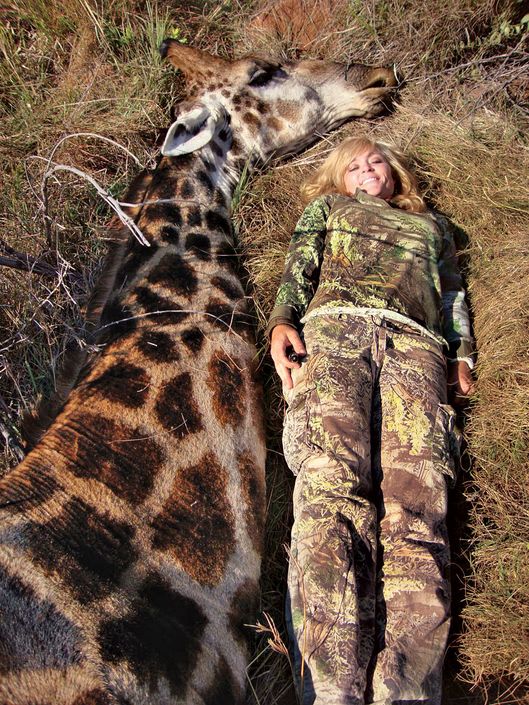
In the child’s menagerie, the giraffe stands apart — gentle, exposed, sweetly awkward, a wildly improbable creature of a mysterious and unpeopled land. He is no one’s pet and no one’s predator. Even among the most dedicated big-game hunters, men who live to “take” rhinos and elephants and what is called, with the sport’s morbid penchant for enumerative collecting, “the big five,” the tallest living terrestrial animal is not one many dream of killing. But in the photograph that brought Rebecca Francis to the world’s attention, a slain giraffe’s head and neck curve over her five-foot-two frame, very nearly nuzzling her abundant hair. This is a “field photograph” or, more commonly, “hero shot,” which is part of the trophy-taking ritual, though Francis was unusual for lying down next to the giraffe rather than kneeling behind him with bow erect, as if genuflecting in a very scary church. Hunting publications are full of tips for getting the perfect “hero shot,” which include wiping the blood from the animal’s mouth, placing its legs underneath its body, and “skylighting” antlers such that their full magnitude is made visible.
The hero shot, it turns out, is the near-perfect outrage-generating viral item. Gervais’s followers tweeted it 50,000 times more. Francis’s phone began ringing with Facebook notifications and did not stop. There were among these, one imagines, informed arguments about the decline of African fauna, the problem of canned hunts among unscrupulous African outfitters, and the ethical implications of celebratory animal slaughter, but they were buried under something else. “By nature humans, women in particular, give life … not take it,” someone wrote. “This devil b*tch has no place in the world and should be hunted and culled herself.” It was suggested that her children “get skittled by a car right in front of her.” She turned from Facebook to a full in-box and clicked off her email without opening a message.
Inside Edition was first to call. When the story appeared on the local news, Francis went to the supermarket and noticed shoppers glancing up from their phones and back again. Her 15-year-old daughter forwarded her a Photoshopped image in which an arrow pierced her mother’s blood-covered chest. Two weeks after the tweet, her 22-year-old son found and sent her something called “Beauty Pageant Killer,” which turned out to be a Rebecca Francis slideshow accompanied by Auto-Tuned original lyrics and precipitated his mother’s slide into an isolating depression: “How does my hair look? / I’ll put it on Facebook” and “Can I be any more blunt / You’re a cunt.”
“The video really put me over the edge,” Francis says. “And then I started reading the emails.” FROM: James. SUBJECT: You are. MESSAGE BODY: a cunt. FROM: Stopkillingendangeredspeciesyoutastelesscunt@fuckyou.com. SUBJECT: Don’t be a bitch. MESSAGE BODY: You’re a cunt. FROM: Urastupidcunt@hotmail.com. SUBJECT: fuck you. MESSAGE BODY: You are an unspeakably evil, vile, empty-hearted cunt. FROM: Stuart. SUBJECT: final warning. MESSAGE BODY: Normally, Im not for violence against women! However, if I see just one more picture of you with an innocent defenceless creature I’m going to take your fucking eyes out with you still conscious and mail them to your family! I will be getting in touch with several people in UTAH soon to monitor your situation … You are a malignant cunt.
Rebecca Francis was not the first. There had been Texas Tech cheerleader Kendall Jones grinning astride a felled lion. There had been Jen Cordaro, and there had been Melissa Bachman, and there had also been Canadian Eva Shockey, the daughter of a hunter and television host named Jim Shockey — “hunting royalty,” as someone put it to me — and a man with no shortage of dead-animal selfies under his belt.
It takes essentially no effort to find an image of the male Shockey exactly parallel to the one for which his daughter began to receive, in her words, “5,000-plus death threats a day,” and yet Shockey informs me that the highest number of death threats he has ever received in a 24-hour period is precisely 88. Leaving aside the potentially sound reasons for social sanction of a trophy hunter, there is no question that the response to Francis and others has to do with both hunting and gender, so much so that many in the hunting community are convinced of the existence of an organized campaign by animal-rights organizations to raise money by targeting young women. But you don’t have to believe the conspiracy theory — I don’t — to acknowledge that at the individual level, mine and perhaps yours, there is something vastly more shocking about seeing pretty, fashionable, 26-year-old Eva in a fishtail braid next to a dead bear than seeing her unshaven cowboy-hat-and-red-kerchief-wearing dad next to the same.
What is it about a pretty woman with a weapon? All of these rape-threat-inducing photos share the contrivance of a woman prepared for the camera — the highlights, the eyeliner, the bleached teeth — beside some nakedly majestic beast stripped of its dignity, demoted from natural wonder to photo prop. The male Shockey may well have just crawled from a cave for some prebreakfast bear-tussling, but his daughter’s polish suggests a standing appointment with a salon professional. Does the very artifice demanded of women in a cultural context become, in the wild, grotesque? Does the activity euphemistically referred to as “taking care of myself” prevent women from seeming credibly and sportingly of the wild? A hero shot is, among other things, a flag in the ground — I did this, did it here, did it now. And yet beyond the community of hunters, the photo does not evoke a thousand-acre South African game preserve, with its own complicated set of ethics, so much as our intuitions about nature or, more precisely, naturalness, which includes womanliness and animal innocence and prescriptive, ethical eating. This is what distinguishes Francis’s story from other tales of social-media mauling: the naïve way the crusade against her was launched, from an army of iPhones, as a defense of the virgin wild. Among those of us for whom “large-mammal killing” and “vacation” are not synonymous, to look at the photo of Francis is to be reminded of every morality tale we’ve ever heard about dumb greed despoiling something pure and innocent of artifice, from Bambi up through BP and beyond. But that judgment depends on a stable idea of where the wilderness ends and civilization begins, and in the company of trophy hunters, this becomes increasingly difficult to determine.
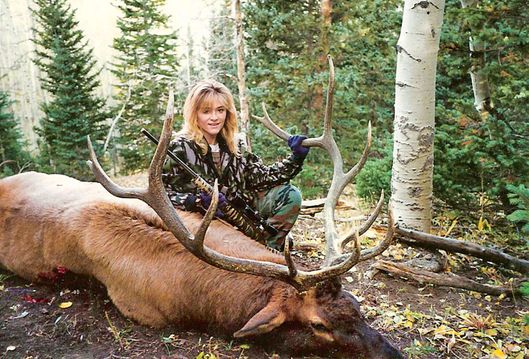
“You don’t know anyone who hunts?” Francis asked me the first day we met. I don’t know anyone who hunts. Francis grew up shooting deer and elk with her father and brothers in central Utah. “Hunting for me all my life,” she says, “has been about family, part of who we are. You can smell the change in the air when it’s gettin’ to fall, and I’ll be like, ‘We’re going to the mountains!’ ”
Before Francis found her husband, Lee, hunting was a casual hobby. When they met on a blind date 20 years ago, he was 38, divorced, with custody of five children, and she was a 21-year-old student with a 2-year-old son. She called him and suggested that they climb Utah’s Mount Timpanogos. “That’s a hard hike,” said Lee, a rock-climbing marathon runner then in the best shape of his life. “Just let me know,” she said at the base of the mountain, “if I am going too fast.” Two weeks later, he asked her to marry him. They were a Mormon family of six. “It was, uh, challenging,” she says now. “I was always the bad guy to someone.” Her oldest stepson was only seven years her junior.
At a time when no one catered to women hunters, Francis brought to her marriage an altered rifle and a closetful of boys’ hunting clothes tailored to fit her frame. Lee introduced her to something more akin to outright survivalism, hunting–cum–adventure seeking in which they’d go after singular game in life-threatening terrain.
By September 2000, they had an 11-month-old named Landon, and Rebecca was four months pregnant with another child. She was still nursing her son, so she took him along on a hunt, riding five hours out to their preferred hunting grounds, a steep, rocky, red-tinged mountainscape with pine forests and open hillsides where deer and elk come out to feed. They pitched a tent for the night, and the next morning, Francis tied a camouflage bandanna around Landon’s head, put him in a backpack, and set out with her rifle. When they spotted deer, they separated. Every so often, Francis stopped to nurse. Late in the day, she shot a buck that had retreated to a steep, rock-covered hillside. She took Landon off her back. To keep him from tumbling down the mountain, she made a little wall of rocks and set him behind it, whereupon she took out her knife and sliced open the deer from tail to skull. As she tells me this, Francis says she finds none of it remarkable, in that there wasn’t anything special about that buck, and among hunters the value of a kill is related to the difficulty of tracking and taking a particular animal, not whether you were pregnant, nursing, or both.
As a kind of musing aside, she mentions that on that trip, her horse wandered off and was stolen. And so, two months later, on another hunting trip, she found herself riding an unfamiliar animal. It was winter by then, and they were riding over a steep, icy pass when the horse tripped and fell onto its side, catching Francis between the hill and the horse, shattering numerous bones in her foot. She and Lee rode the five hours to the road and drove 90 minutes to a hospital in Jackson Hole. Because she was pregnant, she refused any pain medication, including acetaminophen. It remains the worst pain she has ever been in — far worse, she says, than the unmedicated labor she underwent while the foot was healing. A few months later, she would learn that a familiar-sounding horse was going up for auction three and a half hours away. Now eight months pregnant, standing on asymmetrical legs, wearing a boot on her foot, she bought it back.
The stories of which Francis is most proud involve rare animals in dangerous terrain, the kind of kills other hunters envy. Consider her epic two-week sheep hunt in Alaska, undertaken with Lee in 1997. This involves, in extremely compressed summary: being dropped at the bottom of a 3,000-foot Alaskan glacier with a 50-pound pack and as many miles from anything; crossing said glacier over a day of difficult hiking; climbing the steep shale, surface-of-the-moon-like striated cliffs, on which sheep actually live; camping on plateaus so small they can’t accommodate the entire tent; remaining in that tent through a three-day rainstorm that drives the peak right off an adjacent mountain; running out of food; climbing back over the glacier to get to where the plane can drop more food; returning, once again over the glacier, to the cliffs; camping through a terrifying windstorm that threatens to sweep the tent off the mountain; engaging in an activity Francis calls “celebrating our anniversary” on a cliff while waiting for sheep to show up; shooting a ram from 500 yards at dusk; watching that ram tumble in a kind of blur of white and gray down a ravine in the glacier; having no idea which ravine; returning to camp for a few hours’ sleep; waking up to search for the carcass; spotting, by incredible luck, the mangled ram at the bottom of a ravine; slicing the ram open to look for any meat not ruined by bone fragments; and carrying the ram back over the glacier. Francis’s pack, when she made the sheep-meat-laden journey back, weighed 90 pounds. She weighed 115.
By now, Lee says, Rebecca has “outshined him in every way — bigger sheep, bigger elk, everything.” When she became bored with the rifle — at some point, it no longer struck Rebecca as sporting to shoot from 100 yards away — Lee gave her a bow, which requires more strength, a lighter foot, and the ability to watch with equanimity as a slight breeze wafts your arrow away from an animal you’ve spent days shadowing. Francis excelled, in part because she is, in Lee’s words, “sneaky, like a cougar,” capable of inching right up to an animal that he and most hunters would send running. On a trip in 2010, she spotted an elk browsing in a stand of pine and quaking aspen. She left Lee behind and, over the course of three or four hours, slithering and crawling and tiptoeing from log to bush to log, made her way over to them. There were 20 or so, many females and a few bulls, only ten yards from where she lay on her stomach. “I could see their eyelashes when they were blinking,” she says, “their chests when they breathed. I had chills going down my arm.” The largest bull, warning off the other males, tilted his head up into the air and pressed his horns against his back. He started to scream, an earsplitting, high-pitched bugle. Francis tried to control her breathing. Another bull screamed in response. She lay listening among the harem for two hours.
“When you’re right there next to them,” she says, “you’re holding your breath, hoping that the moment continues. I’ve dreamed about it since it happened. You can see elk in parks and zoos, but here they are in their element, acting like they do. It’s a relationship I built with them that few people ever have. It’s you and God’s creation. It’s as close to God as you can get.”
In 2011, on an Alaskan mountaintop, Francis killed what was then the third-biggest dall ram ever taken with a bow. In 2014, she became the second woman archer in history to kill all four species of wild sheep, known as sheep hunting’s “Grand Slam.” And by then, Francis had competition: The number of American women hunters increased by 20 percent between 2006 and 2011, even as the number of male hunters fell. Last year, Eva Shockey appeared on the cover of Field & Stream, the second woman to do so in the magazine’s 119-year history and the first who wasn’t queen of England. Francis no longer has to alter boys’ gear, or buy gear at all, as she has a deal with a young company called Prois that caters exclusively to women.
And yet when hunters see a Rebecca Francis hero shot, they still picture her husband beyond the frame. “Women get that whole thing like, ‘You got the animal because somebody took you there and put you in front of it,’ ” says Lee. “The perception is that women don’t know how to hunt, they just go with somebody that does. Even my brothers and my son say, ‘She is just getting them because you are taking her.’ ”
“I have spent days and days in the mountains,” Francis says. “I have hunted at 10,000- and 11,000-feet elevation. I’m the second woman to do a Grand Slam. They say I can’t do it without my husband, but I am a guide; I guide hunters. Last year, someone dropped me off in the middle of nowhere in Alaska in a Super Cub, and I stayed out there for over seven days and got a black bear and a caribou. I don’t need my husband, is what I am saying. I can take off with the horses on my own.”
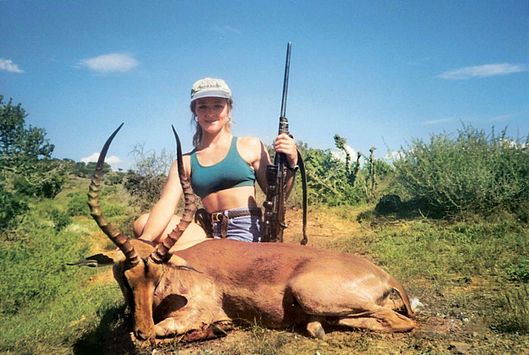
Part of the oddity of Francis’s story is that for every hunter ready to condemn her as a beauty-queen poser — and there are plenty of salt-of-the-Earth meat hunters who find trophy hunters in general loathsome, effete one percenters — one can find a pragmatic conservationist with a ready defense. Conservationists like Susie Offord of Save the Rhinos International, who believes trophy hunting to be a “conservation tool,” necessary to the “incredibly expensive” task of preventing habitat loss and poaching. Conservationists like John Hanks, former head of the World Wildlife Fund’s South Africa chapter, who has called trophy hunting “absolutely essential if we are going to look for the long-term future for rhinos in the whole of Africa.”
The story to which conservationists return is Kenya, which banned trophy hunting in 1977 and as a result, according to Catherine Semcer of the anti-poaching NGO Humanitarian Operations Protecting Elephants, “has lost between 60 and 80 percent of their large mammals outside of parks.” Animals not tied to anyone’s financial interest, in other words, are likely to succumb to well-armed poachers, habitat loss, or pissed-off farmers. If extinction is your primary concern — and let’s allow that trophy hunting brings up many other concerns having to do with animal suffering and much else — the problem is not Rebecca Francis, nor the Texan who, in May, paid the Namibian Ministry of the Environment and Tourism $350,000 for the right to hunt an endangered species of rhinoceros. The problem is the estimated 30 bands of poachers who invade Kruger National Park every single day, men who descend in helicopters, tranquilize rhinos, hack off their horns, and leave them to die. As a conservationist, the enemy of your enemy is your friend, and in this case the enemy of your enemy is the man who profits by legally breeding lions, rhinos, and leopards on his private property, who furthers the bloodline for a price, who can afford the fences and, increasingly, the armed guards needed to keep out poachers. If you spend your days worrying about the future of African elephants, as Semcer does, you will likely consider the possibility of a ban on trophy hunting to be nothing short of “catastrophic.”
The fenced land on which Francis is hunting belongs to George Henry, a former building contractor who has turned his property into a breeding ground where nyala, antelope, and Cape buffalo are raised to be sold to South Africans with other tracts of land, where they will be hunted. Nothing procreates in this farm — and that’s the word Henry uses, farm — without his planning it. The concept of hunting-opportunity-as-commodity is so entrenched in South Africa that at an elementary-school fund-raiser we would later attend with Faul, the woman who decorated the prettiest table was awarded with an impala, by which was not meant that she would keep it as a pet. And while there is a happy concordance of conservation and capitalist aims, game farmers are not do-gooder environmentalists. The same market that preserves so much habitat and protects so many species has birthed a craze for mutants — black impalas, for instance — which pushes breeders to provide ever more freakish prey, which, according to at least one guide I spoke to, results in weaker animals that do fine in the fenced properties of South African concessions but would struggle in the wild.
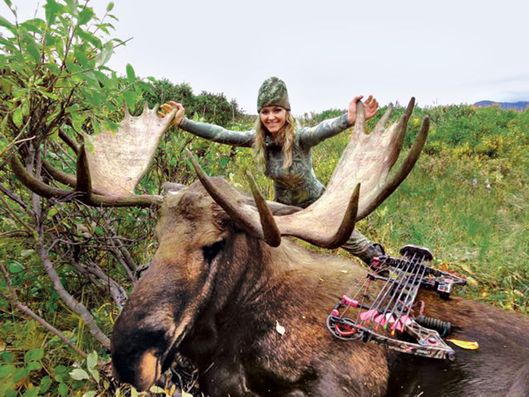
The sable antelope is a stout creature, more horse than deer, with a white face and long, ringed horns that shoot up and curve gently backward, like ossified antennae. The one Henry will permit Francis to kill is 8 or 9 years old (in the wild, they live to about 16) and has fathered perhaps 15 young. The sable has lived his entire life on this farm; he was born and raised to be killed. Henry wants a better, younger specimen to take his place among the females.
Faul jumps out of the car to call someone to open the gate. Last night, Francis showed Faul the video she found so upsetting. He jumps back in the car singing: “She’s a beauty-pageant killer!”
“It’s just … that someone would go through so much trouble,” says Francis, an edge of frustration in her voice, “to write the lyrics and everything.”
“I’m going to make it my ringtone,” says Faul.
Francis stares out the window. “It does have a good beat,” she says.
We tuck back into our blind. It’s cold to be still, 40 degrees, and we’re in hats and gloves and scarves. Francis, very slowly, moves toward the hole and throws some powder into the air. It whorls and disappears. She shakes her head. If he has smelled us, he’ll stay away, and we’re wasting our time. Francis is eager to get out and chase after the sable herself, even though Faul and Henry seem to think that’s entirely pointless, especially with a bow.
Around 5 p.m., after eight hours of waiting, George Henry picks us up. Henry says there is another sable, a 10-year-old, also available to hunt, because Henry doesn’t consider him high-quality enough to breed. He drives us to that sable’s favorite spot. From the jeep, we see a long, sleek horn and a flash of white above the grass. The jeep stops; the sable runs. Francis and Faul hop out into the waist-high grass. Faul and Henry suggest that they build a blind in the trees and shoot the animal when he approaches the fence. “That’s unethical,” says Francis, who heads in the opposite direction.
The ground is a mess of crunchy grass and twigs that snap when stepped on. Francis, walking on the front of her feet, moves deliberately. As the tall grass leads to dry trees, she presses through by plucking thin, bendy branches from her jacket with extreme delicacy, then turning to guide them back into place. Every ten steps or so, she stops to listen. When Francis stalks something, she prefers to be alone, because she is more light-footed than the men usually accompanying her. Nevertheless, Faul is right behind her with a rifle, lest she wound the animal or tempt a buffalo. He steps on a twig: crack. He and Francis freeze. They continue on. Eighty yards from the road, they find some freshly churned red dirt where the sable had bedded down, along with some droppings. Francis turns to her right. In the corner of her eye, she sees what she calls “a shine” — a small, subtle glimmer in the distance, like light on a mirror. It is the very tip of the sable’s horn, reflecting in the sun, and through binoculars she makes out the rest of his body as a darkness behind the grass. She watches him look left, right, looking for them. When he moves, they move, so that his sound masks theirs. He is doing just what they do — walking, stopping, listening. Francis’s heart is pounding.
They walk a bit further and hunch down. A branch cracks in the far distance; he is gone.
Twenty-five years ago, when she was a shy, lonely 16-year-old sophomore in high school, a pack of six girls attacked Francis in a restaurant parking lot. Her mother remembers her coming home “bloody, black and blue, swollen around the teeth.” She thought her daughter had been in a car accident. Francis was so frightened that she stopped attending school and eventually enrolled elsewhere, waiting for the girls to graduate so she could return.
“When the Ricky Gervais thing went down,” Francis says, “I thought, I have had to deal with this my entire life. Now it’s the entire world. Those girls in high school, they didn’t even try to get to know me. And the people emailing — they don’t know what kind of mother I am. They don’t know anything about me.”
The morning after the aforementioned school fund-raiser, in which highly inebriated parents were throwing back tiny bottles of sherry, one of Faul’s friends offers to make us vodka–and–orange juice to take the edge off. Francis, who is new to drinking, thinks she is joking. “Hair of the what?” she says. Faul reminds her that the night previous she had said a swear word (she has asked me not to repeat it here). Her eyes get wide.
“I am so sorry,” she says.
“I think I’m going to need therapy,” says Faul.
I ask Francis, one more time, why we can’t just look at the sable. Wasn’t it enough to be among those screaming elks? Why was it necessary to launch an arrow into the bull that sent chills down her spine?
There is a long pause in which it feels like she is politely trying to find a language I can understand, though I’ve demonstrated myself to be pretty dense about the whole thing. “It’s like,” she says, “you look at dogs. You have these cute lapdogs, and they’re sweet and tender. But then you have dogs that are natural hunters. That’s just who they are. It doesn’t make them a bad dog. They’re still dogs. And some people are made different. It’s not because I want to go murder something and take something’s spirit. It’s, I’m gonna provide meat for my family. I’m gonna have an experience in nature. I’m gonna be one-on-one with this animal.”
On the long flight home, I look again at the picture. I have by this time seen pictures of Francis scraping the meat from a moose in which most of her body is literally inside the moose. She is a survivalist chasing violent communion with nature, almost unimaginably tolerant of physical pain. The giraffe in the photograph is an animal that exists to be killed by people like Francis, wild but not quite wildlife, live but not quite livestock, his entire life scripted from conception onward to provide hunters with the idea of wilderness in a place where wilderness has been made impossible.
Francis was supposed to fly home the same day I did, but she stayed behind, and days later she sends me a video. It is late in the afternoon. The sable — our sable — stares into the camera. He lowers his head, black but for a white streak down the middle, as if weighed down by his massive arcing horns, twin C’s curving three feet down his back. The sound of an arrow piercing flesh is a dull thwack, and with it he jolts back toward the trees, leaving in his place a swirling cloud of dust. Francis and Faul wait for him to die. They follow a trail of blood and fur and the hoofprints of a wounded animal, not evenly spaced but the aimless steps of something thrown terribly off course.
Later, Faul and Francis return in the dark in the jeep along with three guides from the lodge. The sable is on his side, legs splayed, head on the ground, with the arrow jutting out of his shoulder. His mouth is a smear of blood, and the fur on his left has gone stiff and sticky from the leaking wound. Without hesitation, two men take the sable’s legs and two the horns. They drag him toward the car, into the circle the headlights make in the dirt. Francis tries to yank out the arrow, but the broad head is so buried in muscle she needs Faul. The guides swipe handfuls of fallen leaves against the sable’s teeth. They shove his legs underneath his body and, grabbing his horns, point his nose into the dirt so his head stands erect. Francis kneels against the sable and, without intending to, presses her knee into his wound. As blood seeps up her pant leg, she tilts her head to the left, lifts her chin, and smiles.
*This article appears in the July 27, 2015 issue of New York Magazine.